2013 California Standards for Accessible Design Pocket Guide
11B-604.8 Toilet compartments.
Wheelchair accessible toilet compartments shall meet the requirements of Sections 11B-604.8.1 and 11B-604.8.3 _|Coat Hooks and Shelves|_. Compartments containing more than one plumbing fixture shall comply with Section 11B-603. Ambulatory accessible compartments shall comply with Sections 11B-604.8.2 and 11B-604.8.3.
11B-604.8.1 Wheelchair accessible compartments.
Wheelchair accessible compartments shall comply with Section 11B-604.8.1.
11B-604.8.1.1 Size.
Wheelchair accessible compartments shall be 60 inches (1524 mm) wide minimum measured perpendicular to the side wall, and 56 inches (1422 mm) deep minimum for wall hung water closets and 59 inches (1499 mm) deep minimum for floor mounted water closets measured perpendicular to the rear wall. Wheelchair accessible compartments shall additionally provide maneuvering space complying with Section 11B-604.8.1.1.1, 11B-604.8.1.1.2, or 11B-604.8.1.1.3, as applicable. Wheelchair accessible compartments for children’s use shall be 60 inches (1524 mm) wide minimum measured perpendicular to the side wall, and 59 inches (1499 mm) deep minimum for wall hung and floor mounted water closets measured perpendicular to the rear wall.
11B-604.8.1.1.1 Maneuvering space with in-swinging door.
In a wheelchair accessible compartment with an in-swinging door, a minimum 60 inches (1524 mm) wide by 36 inches (914 mm) deep maneuvering space shall be provided in front of the clearance required in Section 11B-604.8.1.1. See Figures 11B-604.8.1.1.2 (b) and 11B-604.8.1.1.3 (b).
11B-604.8.1.1.2 Maneuvering space with side-opening door .
In a wheelchair accessible compartment with a door located in the side wall or partition, either in-swinging or out-swinging, a minimum 60 inches (1524 mm) wide and 60 inches (1524 mm) deep maneuvering space shall be provided in front of the water closet. See Figure 11B-604.8.1.1.2.
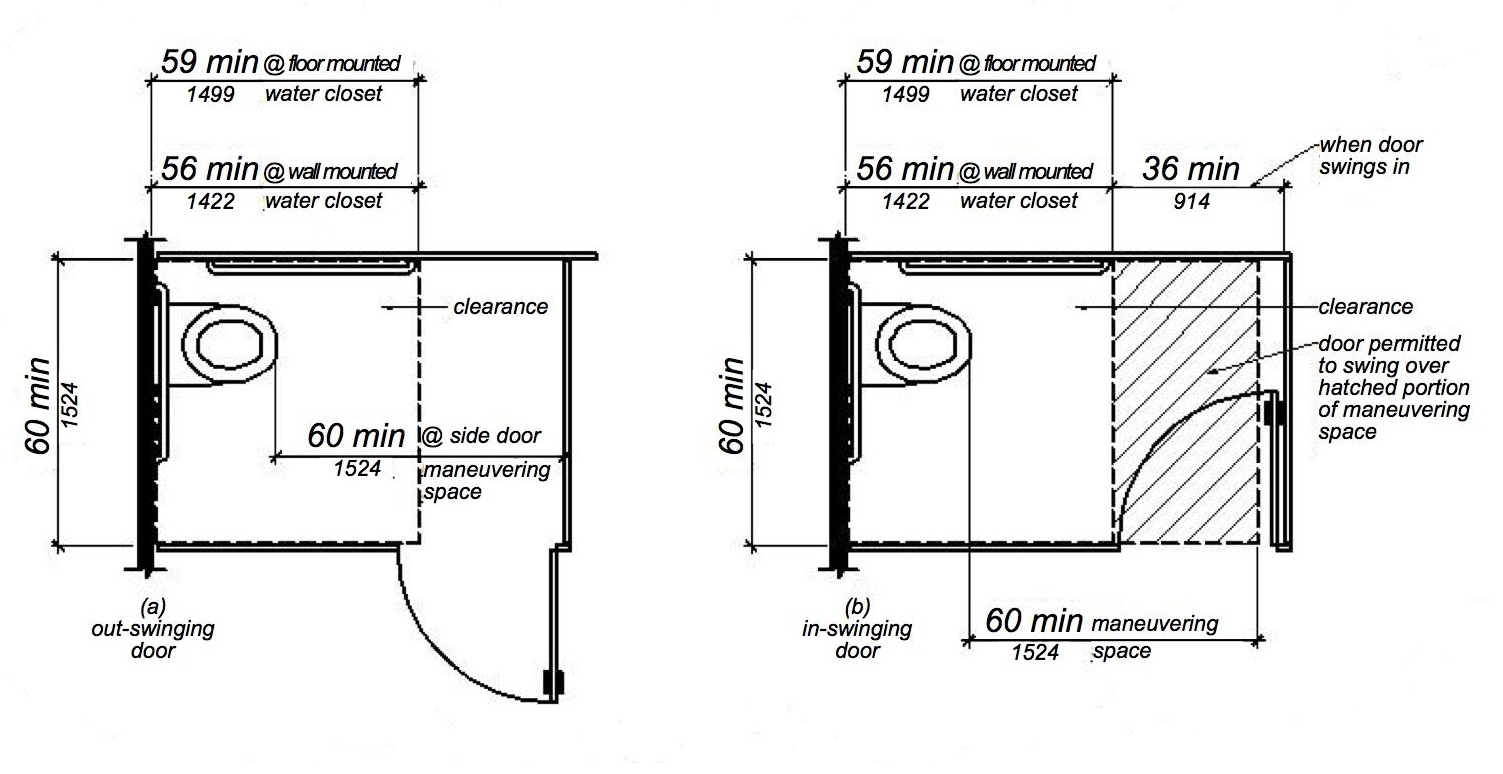
MANEUVERING SPACE WITH SIDE-OPENING DOOR
11B-604.8.1.1.3 Maneuvering space with end-opening door.
In a wheelchair accessible compartment with a door located in the front wall or partition (facing the water closet), either in-swinging or out-swinging, a minimum 60 inches (1524 mm) wide and 48 inches (1219 mm) deep maneuvering space shall be provided in front of the water closet. See Figure 11B-604.8.1.1.3.
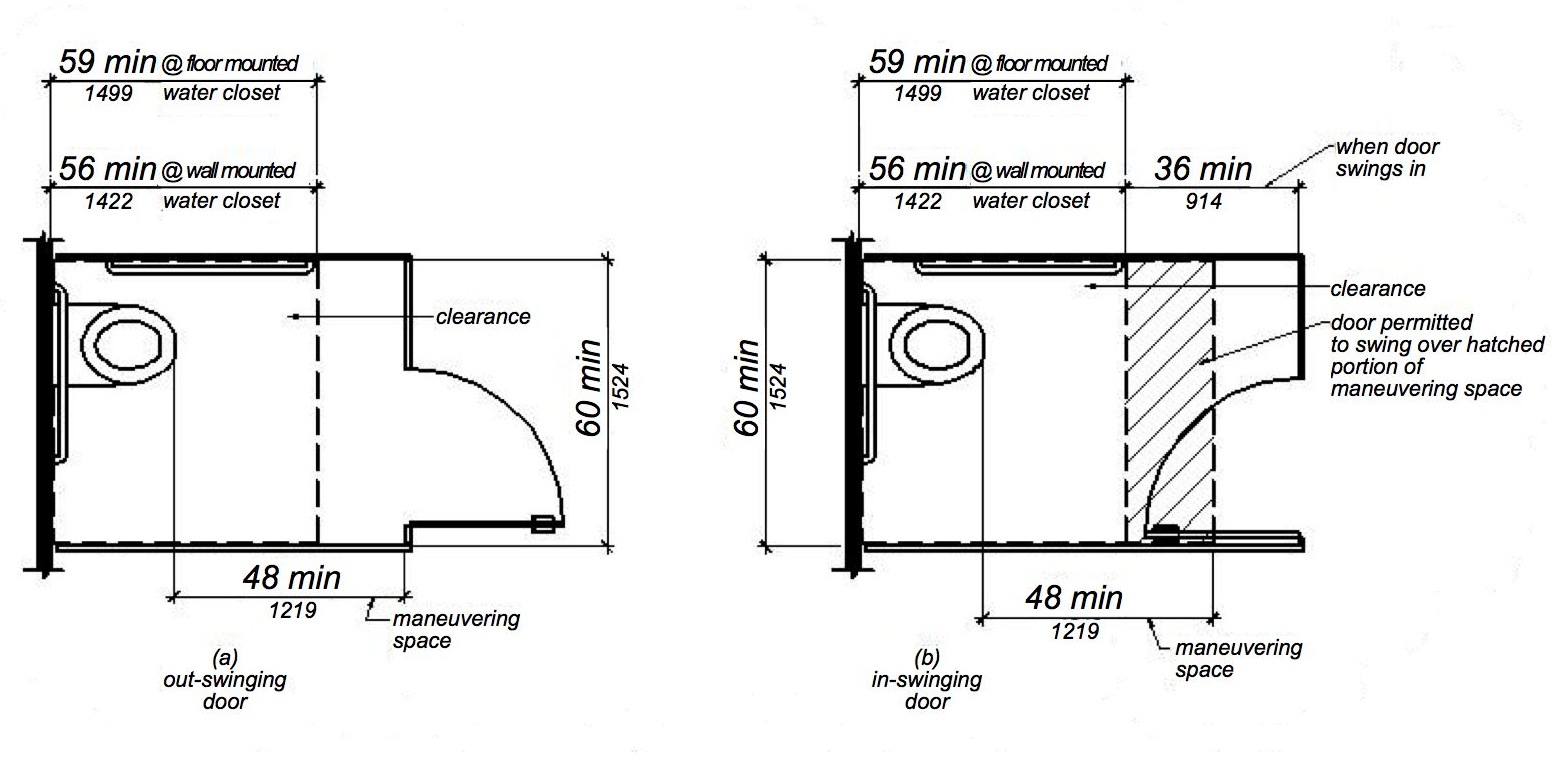
MANEUVERING SPACE WITH END-OPENING DOOR
11B-604.8.1.2 Doors.
Toilet compartment doors, including door hardware, shall comply with Section 11B-404 except that if the approach is from the push side of the compartment door, clearance between the door side of the compartment and any obstruction shall be 48 inches (1219 mm) minimum measured perpendicular to the compartment door in its closed position. Doors shall be located in the front partition or in the side wall or partition farthest from the water closet. Where located in the front partition, the door opening shall be 4 inches (102 mm) maximum from the side wall or partition farthest from the water closet. Where located in the side wall or partition, the door opening shall be 4 inches (102 mm) maximum from the front partition. The door shall be self-closing. A door pull complying with Section 11B-404.2.7 shall be placed on both sides of the door near the latch. Doors shall not swing into the clear floor space or clearance required for any fixture. Doors may swing into that portion of maneuvering space which does not overlap the clearance required at a water closet.
[2010 ADAS] 604.8.1.2 Doors. Toilet compartment doors, including door hardware, shall comply with 404 except that if the approach is to the latch side of the compartment door, clearance between the door side of the compartment and any obstruction shall be 42 inches (1065 mm) minimum. Doors shall be located in the front partition or in the side wall or partition farthest from the water closet. Where located in the front partition, the door opening shall be 4 inches (100 mm) maximum from the side wall or partition farthest from the water closet. Where located in the side wall or partition, the door opening shall be 4 inches (100 mm) maximum from the front partition. The door shall be self-closing. A door pull complying with 404.2.7 shall be placed on both sides of the door near the latch. Toilet compartment doors shall not swing into the minimum required compartment area.
Exception: When located at the side of a toilet compartment, the toilet compartment door opening shall provide a clear width of 34 inches (864 mm) minimum.

The door is required to have a latch which is flip-over style, sliding or which otherwise does not require the user to grasp or twist. This is to facilitate latching the door by people with limited hand or finger dexterity.
The last part of this item addresses the required maneuvering space at the compartment door. This space is required to comply with requirements for door maneuvering space in Section 11B-404.2.4, except the space in front of the door shall be no less than 48 inches deep, measured perpendicular to the closed door. Where Figure 11B-404.2.4.1 (f) and (j), specifically allow a 44” minimum maneuvering space perpendicular to doors in general in the closed position, a minimum of 48” must be provided in order to comply with Section 11B-604.8.1.2.
Note that in Figure 11B-404.2.4.1 (c) the front approach requires 12 inches of strike-side clearance on the push side where a door has both a latch and a closer. However, the US Department of Justice has indicated that a self-closing compartment door with a gravity hinge is not considered to be a door with a closer; hence the 12-inch clearance would not be required in this type of design. ◼
ETA Editor's Note
For wheelchair accessible compartments with in-swinging doors, the compartment size required by CBC is nominally the same as required by 2010 ADAS. For compartments with out-swinging doors, 2013 CBC requires larger compartments than 2010 ADAS due to the 48” minimum maneuvering space required in front of the water closet by 11B-604.8.1.1.3.
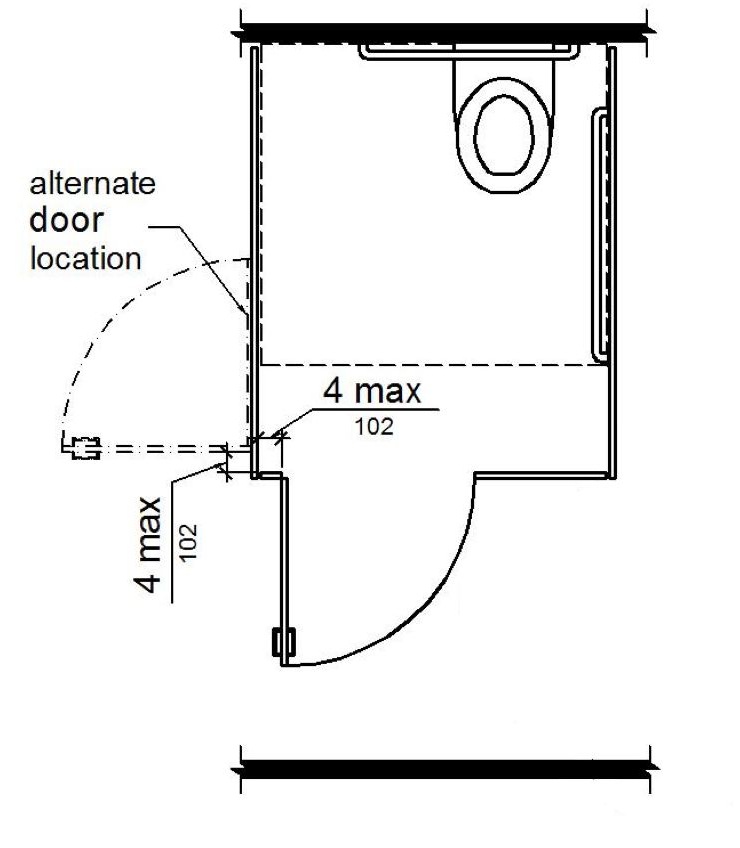
WHEELCHAIR ACCESSIBLE TOILET COMPARTMENT DOORS
11B-604.8.1.3 Approach.
Compartments shall be arranged for left-hand or right-hand approach to the water closet.
11B-604.8.1.4 Toe clearance.
At least one side partition shall provide a toe clearance of 9 inches (229 mm) minimum above the finish floor and 6 inches (152 mm) deep minimum beyond the compartment-side face of the partition, exclusive of partition support members. Partition components at toe clearances shall be smooth without sharp edges or abrasive surfaces. Compartments for children’s use shall provide a toe clearance of 12 inches (305 mm) minimum above the finish floor. [S.H.: Previous editions of CBC did not require toe clearance at accessible toilet compartments, since the minimum size allowed for these compartments would qualify them for the exemption at 1991 ADAAG 4.17.4.]
[2010 ADAS] 604.8.1.4 Toe Clearance. The front partition and at least one side partition shall provide a toe clearance of 9 inches (230 mm) minimum above the finish floor and 6 inches (150 mm) deep minimum beyond the compartment-side face of the partition, exclusive of partition support members. Compartments for children’s use shall provide a toe clearance of 12 inches (305 mm) minimum above the finish floor.
Exception: Toe clearance at the side partition is not required in a compartment greater than 66 inches (1676 mm) wide.
[2010 ADAS] EXCEPTION: Toe clearance at the front partition is not required in a compartment greater than 62 inches deep with a wall-hung water closet or 65 inches deep with a floor-mounted water closet. Toe clearance at the side partition is not required in a compartment greater than 66 inches (1675 mm) wide. Toe clearance at the front partition is not required in a compartment for children’s use that is greater than 65 inches deep.
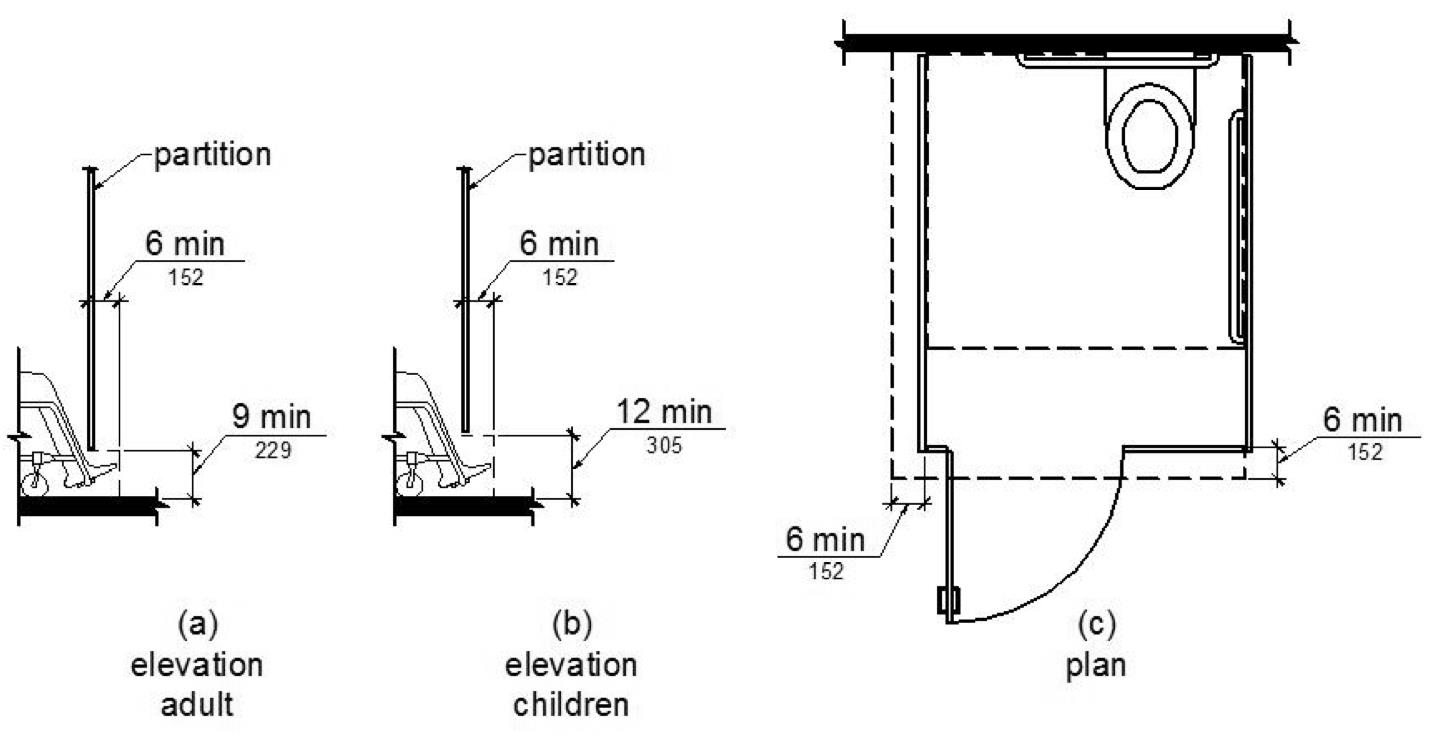
WHEELCHAIR ACCESSIBLE TOILET COMPARTMENT TOE CLEARANCE
11B-604.8.1.5 Grab bars.
Grab bars shall comply with Section 11B-609. A side-wall grab bar complying with Section 11B-604.5.1 shall be provided and shall be located on the wall closest to the water closet. In addition, a rear-wall grab bar complying with Section 11B-604.5.2 shall be provided. Where separate grab bars are required on adjacent walls at a common mounting height, an L-shaped grab bar meeting the dimensional requirements of Sections 11B-604.5.1 and 11B-604.5.2 shall be permitted.
[2010 ADAS] 604.8.1.5 Grab Bars. Grab bars shall comply with 609. A side-wall grab bar complying with 604.5.1 shall be provided and shall be located on the wall closest to the water closet. In addition, a rear-wall grab bar complying with 604.5.2 shall be provided.
ETA Editor's Note
See the ETA Editor's Note following Figure 11B-604.5.1 pertaining to the coordination of nurse call devices with side grab bars at accessible water closets in Hospitals and other facilities under OSHPD jurisdiction.
11B-604.8.2 Ambulatory accessible compartments.
Ambulatory accessible compartments shall comply with Section 11B-604.8.2.
11B-604.8.2.1 Size.
Ambulatory accessible compartments shall have a depth of 60 inches (1524 mm) minimum and a width of 35 inches (889 mm) minimum and 37 inches (940 mm) maximum.
11B-604.8.2.2 Doors.
Toilet compartment doors, including door hardware, shall comply with Section 11B-404, except that if the approach is to the latch side of the compartment door, clearance between the door side of the compartment and any obstruction shall be 44 inches (1118 mm) minimum. The door shall be self-closing. A door pull complying with Section 11B-404.2.7 shall be placed on both sides of the door near the latch. Toilet compartment doors shall not swing into the minimum required compartment area.
[S.H. 1115B.3.1, Item 5]11B-604.8.2.3 Grab bars.
Grab bars shall comply with Section 11B-609. A side-wall grab bar complying with Section 11B-604.5.1 shall be provided on both sides of the compartment.
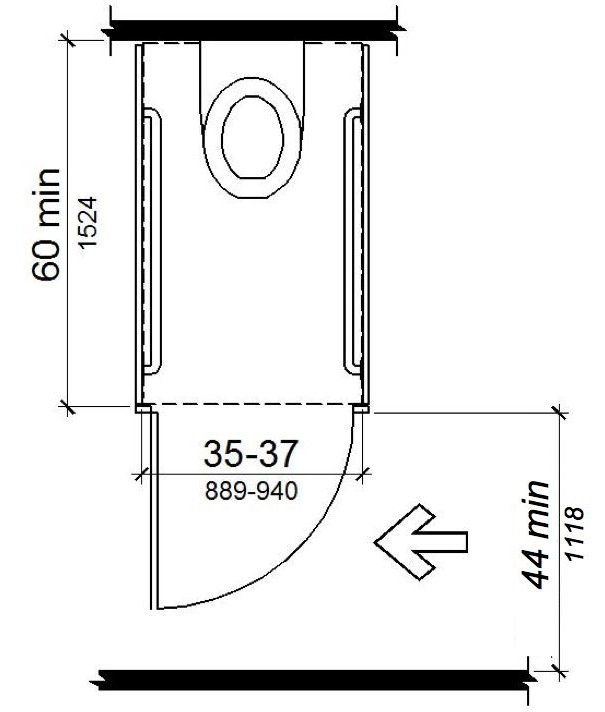
AMBULATORY ACCESSIBLE TOILET COMPARTMENT
11B-604.8.3 Coat hooks and shelves.
Coat hooks shall be located within one of the reach ranges specified in Section 11B-308. Shelves shall be located 40 inches (1016 mm) minimum and 48 inches (1219 mm) maximum above the finish floor. [S.H.: For coat hooks, see Safe Harbor at Subsections 11B-308.3.1 & 11B-308.3.2] For shelves, see [S.H. 1125B.3].

User Comments/Questions
Add Comment/Question